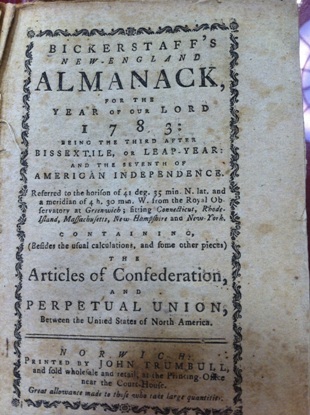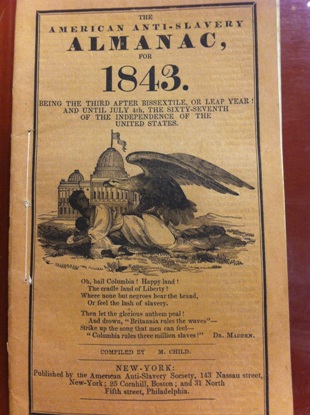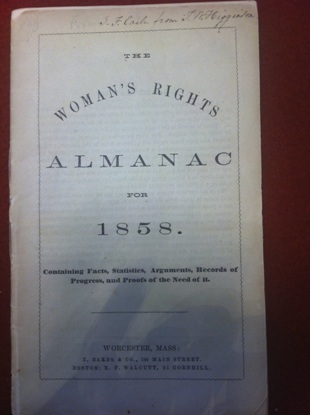Voices from the Sylff Community
Mar 5, 2014
Narratives of “Change” and “Freedom” in Early Modern Almanacs
One important source of information in examining the social history of the United States and Europe in the early modern era is the almanac. Using an SRA award, Kujtesë Bejtullahu, a Sylff fellow at the Graduate Institute of International and Development Studies, explored the rich collection of eighteenth and nineteenth century almanacs at the American Antiquarian Society to undertake an in-depth study of how early modern society conceived of two precious and finite values—political freedom and the passage of time.
* * *
Time and politics are two basic categories of life. How do we think them together? How do different societies incorporate them into broader narratives of orientation in a changing world? This puzzles me intellectually, and in my dissertation, I explore the affinity between the notion of political liberty and the way in which modern societies think about their relations and change.
I am particularly intrigued with the revolutions of the late eighteenth century—specifically, the American and the French Revolutions—as two significant events in early modern history that witnessed a struggle to not only reconfigure political values and loyalties but also bring about a temporal reorientation through which such changes could better resonate. By the late eighteenth century, not only were political relations recalibrated and wrapped with the notion of “liberty” from various ends, but the political visions and institutional designs emerging from this realignment were also more boldly projected into the distant future, reaching into peoples, places, and times not present. Thus while the notion of political liberty took center stage, at stake was also the concept of change itself, namely, qualifying the ways in which societies and their social relations could change from the ways in which they could not.
To explore this double recalibration of political values and temporal expectations in socio-historic context, I turned to a medium that was particularly popular in early modern society: the almanac. With the support of the Ryoichi Sasakawa Young Leaders Fellowship Fund (Sylff), the American Antiquarian Society, and the Library Company of Philadelphia, I examined if and how this transition was recorded, described, or contested in late eighteenth and early nineteenth century almanacs published in the New World.1
The Almanac

Bickerstaff’s New-England Almanack for 1783 (published by John Trumbull). With Britain close to recognizing American independence, this 1783 New England almanac marked the event by printing the Articles of Confederation. A few years later the Constitutional Convention was held to draft the US Constitution and found the United States of America. (Courtesy of the American Antiquarian Society)
The early modern almanac has been described among others as a ”miniature encyclopedia,” a village library, or the iPhone of early America.2 It has been reported as being second only to the Bible in popularity and among the earliest works published following the invention of the printing press.3 While the late eighteenth century almanac was rarely without basic astral and meteorological information4 and a calendar to mark the passing of time and the “remarkable” days,5 it also contained information deemed useful or entertaining: medical and agricultural advice, proverbs, moral instruction through essays and anecdotes, excerpts from famous books, historical and geographical narratives, social satire, poetry, scientific articles and practical information, such as schedules of fairs, meetings of courts, and currency tables. The astral and practical information in the almanacs was no doubt important, yet some of the most popular, early modern almanacs were ones that included social commentary, political speculation, or entertainment.
The almanac, broadly speaking, was a miscellany, filling a variety of roles in a concise and affordable manner.6 But in another sense, it was a window onto a world of relations and how these varied and mattered for ordinary people. It helped instruct people on how to orient themselves in relation to nature and society, adjust to the changes taking place and live better7. It is not unusual to find among the surviving early modern almanacs people’s inscriptions of important events in their lives and changes in the environment8 or interleaved almanacs that also served as personal diaries.

The American Anti-Slavery Almanac for 1843 (published by the American Anti-Slavery Society). Almanacs addressed such political questions as slavery, with most advocating its abolition and a few endorsing it. Through verse and imagery, the cover of this pre–Civil War almanac draws attention to the persistence of slavery in a country that had declared itself free and was portrayed as the ”cradle land of Liberty.” (Courtesy of the American Antiquarian Society)
Not surprisingly, then, early modern almanacs were sensitive to changes in politics and society, often advocating a particular view of politics and social values over others. During the American Revolution, almanacs began to carry more explicit political content such as political prefaces or engravings, politically charged verse, calendars marking critical political events or purposefully omitting previously celebrated historical dates,9 excerpts from political tracts and formal political documents, such as state constitutions, articles of confederation, or treaties.10 The almanac was similarly mobilized during the French Revolution. 11 Particularly keen at using the almanac propagandistically were the Jacobins, who in 1791 organized a contest for an almanac that would best instruct the people about the revolution. The winner, L'Almanach du Père Gérard—written by Jean-Marie Collot d’Herbois,12 a revolutionary—became a bestseller.13 Moreover, many of the maxims that Benjamin Franklin popularized in his almanac Poor Richard (later compiled in The Way to Wealth) circulated on both sides of the Atlantic. Translated into French shortly before the French Revolution, La Science du Bonhomme Richard was often praised for its good mœurs and appeal to the common man, while revolutionaries like Jacques Pierre Brissot proclaimed, “Behold how Poor Richard and Franklin were always friends of the people.”14 If some of the French revolutionaries saw in Franklin’s almanac a philosophy for the people, well over a century later, Max Weber also turned to almanac wisdom to discuss the emergence of the spirit of capitalism.15
Time and Freedom as Finite Qualities

The Woman’s Rights Almanac for 1858 (published by Z. Baker & Co.). This nineteenth century almanac on women’s rights contains speeches, historical narratives, and statistics that speak to the efforts and struggles of what was later described as the “first wave of feminism.” (Courtesy of the American Antiquarian Society)
What is unique about the almanac is that it was also a finite medium, published annually in rather compact form and with a limited geographic reach as regards its astronomical calculations. Though it contained a miscellany of information, the late eighteenth century American almanac was still a circumscribed window onto the broader world and one offering a finite perspective on the ”good life”. At a basic level, what made life good were two gifts from God—time and freedom. These two were frequently invoked and highly valorized, but also described in finite terms: subject to loss when taken for granted or not vigilantly guarded. As a gift in the form of life, time is irredeemable and can be made meaningful,16 while freedom is something that those who are virtuous can revive or safeguard from being lost.
Generally speaking, there is in many late-eighteenth-century American almanacs a distinct sensitivity to loss and an appreciation of finitude as not merely a condition of life but of the life worth living: the free life. This preoccupation with finitude in its political dimension—that, for example, the freedom acquired by republics is fragile, fugitive, and finite—becomes less noticeable by the early nineteenth century. Increasingly, freedom is projected in more futuristic terms and portrayed as being infinitely resilient under better, enduring laws (such as by being enshrined in the constitution) or with the advent of historical progress.17 As the American colonies declared themselves independent and changed the terms of their political association to constitute the United States, there also arose an eagerness to project their conception of freedom in much more expansive terms, spatial as well as temporal. In retrospect, the American Revolution may well have been the last moment when we thought freedom with finitude.
Early modern almanacs can shed some light on how through familiar notions of liberty and the republic, the articulation of a new experience of “political presence” was coupled with projections of a future in which societies and social relations would advance. This is partly revealed in the transformation of the medium itself. At the beginning of the nineteenth century, the almanac began losing its general feel and became more specialized and theme oriented; by the late nineteenth century, it was becoming somewhat obsolete as other mediums—the clock, newspaper, and thematic books—gained new relevance for people’s temporal orientation and for keeping up to date with the faster-production of useful knowledge. It became necessary for people to take bearings more frequently and from a variety of sources, a phenomenon even more prevalent today, as it is ever more necessary to keep updating one’s skills and expectations.
Giving Finitude Political Expression
![Annuaire Franҫais ou Manuel Du Colon, à l‘usage de Saint-Domingue pour l’An X [1801] (published by Port-Républicain). To mark their break from the ancien régime, the French revolutionaries instituted calendrical reforms that almanacs were compelled to adopt and promote. This almanac for the tenth year of the French Republic informs that the law of 23 Fructidor of year 6 forbids using the calendar of the old era and requires conformity with the law’s spirit, which is “to not leave any trace of the old yearbook”. Published for the colony of St. Domingo (now the Republic of Haiti), this almanac has a unique transatlantic revolutionary feel, recording the insurrections of slaves in the colony, celebrating the leadership of Toussaint L’Ouverture, and printing the constitution of St. Domingo that he promulgated. Controversial and short-lived, this constitution was nevertheless an autonomous act that challenged French colonial policy, prompting Napoleon to secure the capture and deportation of L’Ouverture. L’Ouverture died in prison in Jura, France, in 1803, Haiti achieved its independence in 1804, and Napoleon revoked the French revolutionary calendar in 1806. (Courtesy of the American Antiquarian Society)](/wp-content/uploads/2014/03/4-annuaire-st-domingue_web.jpg)
Annuaire Franҫais ou Manuel Du Colon, à l‘usage de Saint-Domingue pour l’An X [1801] (published by Port-Républicain). To mark their break from the ancien régime, the French revolutionaries instituted calendrical reforms that almanacs were compelled to adopt and promote. This almanac for the tenth year of the French Republic informs that the law of 23 Fructidor of year 6 forbids using the calendar of the old era and requires conformity with the law’s spirit, which is “to not leave any trace of the old yearbook”. Published for the colony of St. Domingo (now the Republic of Haiti), this almanac has a unique transatlantic revolutionary feel, recording the insurrections of slaves in the colony, celebrating the leadership of Toussaint L’Ouverture, and printing the constitution of St. Domingo that he promulgated. Controversial and short-lived, this constitution was nevertheless an autonomous act that challenged French colonial policy, prompting Napoleon to secure the capture and deportation of L’Ouverture. L’Ouverture died in prison in Jura, France, in 1803, Haiti achieved its independence in 1804, and Napoleon revoked the French revolutionary calendar in 1806. (Courtesy of the American Antiquarian Society)
Insofar as the almanac helped people orient themselves and relate to changes in society and their surroundings by reminding them often of conditions of finitude, the story of how the medium became politicized in revolutionary times and later driven into obsolescence is revealing of how the very concept of change was, in the eighteenth and nineteenth centuries, being transformed in ways that remain difficult to comprehend. While the tale of the almanac may be thought of as a story of outgrowing finitude through modern technology, the political aspect should not be overlooked. Seen in a revolutionary context, where ideas of how societies can and should change were being recast and when political freedom was increasingly projected as becoming more resilient, this tale is also one of how modern discourses on emancipation became much more concerned with the production of new and different futures than with giving finitude a more meaningful political form.
At a time when we have capabilities to produce conditions of finitude on a much more radical scale and at a much faster rate,18 it seems relevant to once again consider giving finitude meaningful political expression. As we are confronted with it in more intense, accelerated, and unpredictable forms, we nevertheless rarely consider that political freedom is not so much about the negation or overcoming of finitude but a more meaningful affirmation of it. We struggle, more generally, to articulate and experience “political presence” in an increasingly interdependent world, where different people and societies are drawn into relations but often in ways that they cannot be consciously and considerately be present for one another. Indeed, narratives of temporal differentiation—between the developed and developing, the advanced and lagging—and the governance of expectations of change can also obscure our very sense of contemporaneity and appreciation of what is, can, and must be shared and jointly preserved. It is my concern, in other words, that without engaging more meaningfully with the experience of finitude, contemporary international politics will continue to struggle to make relations between different others meaningful in finite time and to make finite time in relationships meaningful.
Given a dynamic and interdependent modern context that we describe as “international” or “global,” it seems relevant to imagine and recast the experience of “political presence” in a different analytical key, not merely scale. History provides no blueprints in this respect. Yet it seems helpful to convoke it for stimulating insight on how much of what is absent is remembered and projected as present and how much of what is or feels present our discourses still keep absent.
1Mostly almanacs from the American colonies and the United States, and some from Canada, Haiti, and Jamaica.
2 See Molly McCarthy, “Redeeming the Almanac: Learning to Appreciate the iPhone of Early America,” in Common-Place, Vol.11, No. 1 (October 2010).
3 Together with the printing of the Bible in Latin in the 1450s, Gutenberg also printed an almanac in 1457 in Mainz.
4 Such as eclipses, tides, lunations, weather prognostications, the influence of stars and planets, and the zodiac.
5 “Holy” days, historical events, etc.
6 See Marion Barber Stowell, Early American Almanacs: The Colonial Weekday Bible (New York: Burt Franklin & Company, 1977) ix; Bernard Capp, Astrology and the Popular Press: English Almanacs 1500–1800, (London: Faber & Faber, 1979), 23; Louis K. Wechsler, The Common People of Colonial America As Glimpsed Through the Dusty Windows of the Old Almanacks, Chiefly of New-York (New York: Vantage Press, 1978).
7 See the preface to Geneviève Bollème, Les Almanachs Populaires aux XVIIe et XVIIIe Siècles (Paris : Mouton & Com, 1969).
8 Births, deaths, marriages, wars, harvest failures, etc.
9 For example, marking events like the Declaration of Independence and the French Revolution and omitting coronations and birthdays of royalty.
10The French alliance of 1778, for example.
11 See Lise Andries, “Almanacs: Revolutionizing a traditional genre” in eds. Robert Darnton and Daniel Roche, Revolution in Print: the press in France 1775-1800 (University of California Press, 1989), 203-222
12 Jean-Marie Collot d’Herbois participated in the Paris Commune and the National Convention of 1792, but is more commonly known for his involvement with the Committee for Public Safety, in particular the 1793 Reign of Terror in Lyon.
13 See Michel Biard, “L'Almanach du Père Gérard, un exemple de diffusion des idées jacobines,” Annales historiques de la Révolution française; No. 283 (1990) pp. 19-29.
14See Alfred Owen Aldridge, Franklin and His French Contemporaries (New York: NYU Press, 1957) 46.
15 See Max Weber, The Protestant Ethic and the Spirit of Capitalism, trans. T. Parsons (1930), Ch. 2.
16 Almanacs provided much instruction on temporal values and discipline, such as how to make the best use of time.
17 Or as Proudhon later articulated, “the theory of Progress is the railway of liberty.” See the Foreword to Pierre-Joseph Proudhon, The Philosophy of Progress (1853).
18 Such as through nuclear weapons and environmental degradation.
